Snoddy Family History Cead Mile Failte (a Hundred-Thousand Welcomes)
A History of Samuel Snoddy and Elizabeth Sloan
Memorial
Snoddy Family History Cead Mile Failte (a Hundred-Thousand Welcomes)
A History of Samuel Snoddy and Elizabeth Sloan
Memorial
|
|
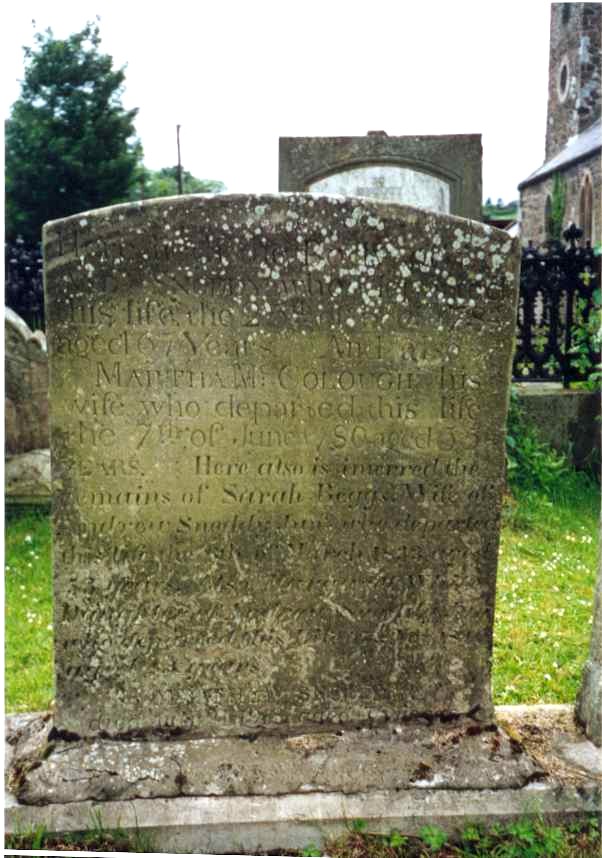 |
|
|
|
 |
 |
|
On January 30, 1748, in London Britain Township, Chester County, PA, Samuel Snoddy witnessed the will of William McCollock/ McColloch, and on March 14, 1748, testified to the will. This places Samuel Snoddy in Chester County between January and March of 1748. It cannot be proven that this is "our" Samuel Snoddy, but the date certainly coincides with the emigration date mentioned in the Stutesman book will ("Samuel Snoddy and Elizabeth Sloane married in Ireland about 1748 and sailed for the colonies of North America and settled in North Carolina."). Also, as stated on the tombstone of Andrew Snoddy in St. Cedma’s churchyard, his wife was Martha McColough. This, once again, links the Snoddy and McColloch families.
In 1749 and 1751, a Samuel Snoddy was on the tax lists for the same township and county stated above; paying “2 shillings, 3 pence” in 1749, and “2 shillings, 6 pence” in 1751. On this same tax list was George McCleave and James Kennedy. George McCleave was the recipient of William McColloch’s wearing apparel in the 1746 will on which Samuel Snoddy and James Kennedy were the witnesses. (Information on tax lists provided by Sharon Haennelt.) This places Samuel Snoddy in Chester County between January and March of 1748, and 1749 and 1751.
It is assumed that the Snoddy family traveled the Great Wagon Road from Philadelphia through Lancaster, York, and Gettysburg. It then turned southwest through Maryland and into the valley of Virginia, passing through Lexington and Fincastle. There it turned south to the Yadkin River in North Carolina. Like many colonial roads, it was little more than a wide dirt road. Travel was slow; even in good weather a wagon could only cover about 10 miles a day. The 435-mile trip took approximately three months. They probably traveled in one of the Conestoga wagons pulled by a team of oxen or horses. The most important reason why the Scots-Irish packed up what little they owned and took the southbound road was the cost of land in Pennsylvania. A fifty-acre farm in Lancaster County, Pennsylvania would have cost 7 pounds 10 shillings in 1750. In the Granville District of North Carolina, which comprised the upper half of the state, 5 shillings would buy 100 acres.
The Scots-Irish presence on the North Carolina frontier was welcomed as a reinforcement against the Indian threat - a threat which kept some of the Ulster families moving on into the sparsely populated upland regions of North and South Carolina. They were warmly received and noted for their honesty, independence of spirit and ability to work hard. They tended to stick together and, because they had little money, were driven to the frontier regions, the hills and inland areas, where land was cheap. Our ancestors were self-sufficient farmers. Nearly everything they owned was homemade. They lived in one-room cabins built of logs cut from the surrounding forests. They had what it took to flourish in the back country - "the right stuff" of the 1700’s. They grew crops such as corn, tobacco, beans and squash in stump-filled fields. A fence protected crops from the livestock, usually just a few pigs and cows. Families who stayed long enough began to grow wheat and barley.
|
 |
|
Agness did not remain a widow very long - in August 1759, "James Neil" made bond in Rowan County Court for his marriage to "Ann Snoddy". We know this was "Agness" because in her August 1793 will, "Agnes Neill" names among her heirs, "Son Andrew Snoddy."
John and Agnes/Ann Snoddy had two sons that are documented; John, Jr. and Andrew. Andrew was born circa 1755-59, and was still a minor when his elder brother, John Jr. made his will in February of 1775. In his will, John states: "I give to my brother Andrew Snoddy all my Estate provided he lives to the age of Maturity. But in case he Dies a Minor and without legitimate Issue I allow My Cousin John Snoddy the sum of Ten Pounds. And I do Constitute the said Andrew under the Guardianship of my Uncle Samuel Snoddy and of Joseph Steel." This statement establishes that John Snoddy and Samuel Snoddy were brothers.
In April 1781, John’s son, Andrew became the Adjutant of the First Regiment of South Carolina State Troops under the command of Lt. Colonel Wade Hampton. After the war he returned to North Carolina and in January 1786, he signed a security bond in Rowan County for the marriage of his half-sister, Elizabeth Neill. He then shifted west, stopping first in the Nashborough settlements, then continuing into Louisiana where the 1810 Federal Census counted him in Rapides Parish on the Red River. In 1819, his half-brother, James "Nail [Neil]" swore in Butler County, Kentucky, court that "Andrew Snoddy died near Natchitoches Pecan Point." Pecan Point was one of the principal early settlements on the Red River in the Arkansas Territory north of Louisiana.
The earliest documented record of Samuel Snoddy in North Carolina is a petition from settlers to the King of England and the Earl of Granville, dated 1759 (text of petition shown on next page).3 Other signers were William Morrison and John Ireland, who were granted land in the Elk Creek area in 1751. The next record of Samuel is his 1764 bounty claim of four wolf scalps on the Rowan County court.
It is possible that other of Samuel’s children were born in North Carolina, but the first documented proof we have is that of his fifth child, John, stating in his Indiana revolutionary war pension application, that he was born in Rowan County on February 23, 1758. All the other children born prior to 1758 were either born wherever the family landed in America (probably Pennsylvania) or while the family was migrating into the North Carolina frontier.
The family was in North Carolina in 1759. William would have been 10 years old, Eleanor-8, Sarah-6, Elizabeth-4, Margaret-3, John-1, and Fergus was only born in October of 1759. Traveling through the wilderness frontier of hostile Indians with five small children and a pregnant wife would have been very challenging. These children were raised on a farm in what is now the southeast corner of Alexander County. At the time of Margaret’s birth in 1756, the Cherokees were burning out the settlers on this frontier. Fort Dobbs was the center of protection and resistance for the pioneers. It was constructed in 1756, about three miles north of the Fourth Creek Settlement, and a short distance south of the South Fork of the Yadkin River.
By 1764, Samuel had seven children: (1) William, (2) Eleanor, (3) Sarah, (4) Elizabeth, (5) Margaret, (6) John, and (7) Fergus, [four other children were born prior to 1768]: (8) Mary, (9) Agnes/Nancy, (10) Martha Sloan, (11) Samuel Jr., and (12) Thomas.
On July 22, 1768, Samuel (age 48) and his son, William (age 19), were listed in the Rowan County, North Carolina, tax table in Captain Purviance’s district [one of Purviance’s sons, John, was later to marry Samuel Snoddy`s daughter, Martha, in 1791]. Between 1771 and 1779, William served in the North Carolina state militia during the "War of Regulation". He is listed on the payroll for a company of state militia in Captain William Morrison’s district, which served under General Hugh Waddell.
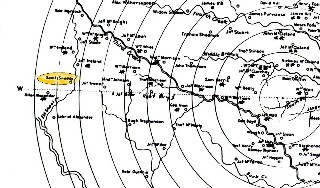 |
|
 |
|
The following is a quote from John Mantle Judah: "The well-known story of the elopement and marriage of my grandparents is that Joseph was one morning at work, roofing a house. His father came and said, 'Joe, that old fool Snoddy is going to marry his girl Margaret to so-and-so tomorrow. Maybe you'd better go and see about it.' Whereup, Joe hastily clambered down, put on his coat and galloped off several miles to the Snoddy place. That night after the stern old father was asleep, Margaret handed out her bridle and saddle through a window and herself followed. She never saw her parents again, for old Snoddy never forgave her, leaving her a shilling* in his will. The story goes on to say that a younger sister was willing to supply Margaret's place to the bereaved groom [Andrew Mitchell], so that a wedding took place nevertheless." *(Samuel's will actually left his daughter, Margaret, five shillings, the same amount he left his other six children.)
In 1778, Samuel's son, John (age 20) married Agnes Niblock in North Carolina. Around 1780, John migrated to Kentucky and in June of 1787, John and Agnes were admitted to the Walnut Hill Presbyterian Church near Lexington, Kentucky (Fayette County). Agnes died between 1792 and 1795, leaving John with six young children. He moved to Bourbon County circa 1795 and on February 22, 1796, John married Nancy Neel/McNeel. He remained there until circa 1829-30 since he was in the 1800 census and land records show he purchased 133 acres on Rockbridge Creek on April 16, 1803. At this time, he moved to Owen County, Indiana and bought 60 acres in Wayne township, near Gosport. He is listed in the 1830 census and died there on March 22, 1843.
In Wilkes County, North Carolina on March 4, 1778, William Snoddy, Sr. (at age 29) entered 300 acres on the north side of the Yadkin River. On May 6, 1778, Samuel was appointed a "justice". "In November 1778, William was a chain-bearer on a survey of land in Wilkes County for his brother-in-law, Joseph McCorkle." On February 5, 1779, he entered 300 additional acres on Blue Ridge, near the head of the Buffalo and Elk Rivers. On May 6, 1779, he was appointed overseer of a road "from Kerr’s bridge on 3rd Creek through Captain Purviance's district, along with Matt Troy, Joseph Steel and James Brandon."
On March 1, 1780, he received a North Carolina land grant (No. 138) of 195 acres in Wilkes County . "In 1783, William was granted a tract of land in what is now Tennessee under the regulations for laying off the land granted to the Continental Line. Although no service record has survived, it can be properly presumed that William, about thirty years old, marched in the infantry regiments of that ‘line’ which held the central strength of the army of General Washington."
"In 1782, William sold the above land to General William Lenoir", a Revolutionary War hero. This land now lies in Caldwell County near the town of Lenoir. "William Lenoir lived in the log cabin presumably built by William Snoddy called "Old House Hill." In Lenoir’s papers of 1798, he describes the house as "an old log house about 17 by 22, shingle roof, a small kitchen, and smokehouse, both of logs, a tobacco pen and stable" and in 1813 described as "a dwelling house for the miller of logs with shingle roof and stone chimney."
On September 26, 1782, at age 33, William, Sr. married Margrite McNeely [daughter of ?David McNeely] in Rowan County, NC. Several researchers of the Snoddy family believe that William could have had an earlier marriage, but no proof has been found to date.
|
|
(Copy of Marriage Bond provided by Peggy Snoddy Johnson.) |
On the same date, William sold his land in Wilkes County to Elijah Isaacs for 500 pounds. This land record states that William was from Washington County, NC.
On January 30, 1784, William, Sr. received a North Carolina land grant for 640 acres in Davidson County, Tennessee. In August of 1784 he was still in North Carolina, but by 1787 had migrated to Sumner County and is listed in the Sumner County, Tennessee tax records for that year.
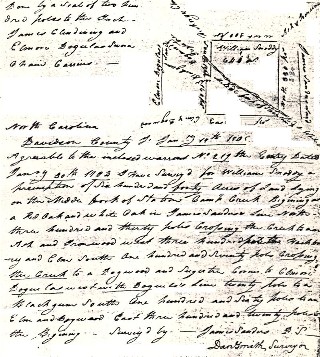 |
|
(Copy of Land Survey provided by Peggy Snoddy Johnson.) |
At age 67, Samuel Snoddy must have been in poor health because on May 9, 1794, he signed his will "with a clear but slightly scraggy ‘Sam’l Snoddy’." "The patriarch would not die as soon as he had expected because the 1800 census counted him in Iredell County with a wife and nine slaves. In 1803 he transferred to his son, Thomas, the title to the 600 acres on Elk Shoals Creek, where he had been living since his settlement in North Carolina."
On August 16, 1806, Samuel’s son, Thomas (executor), made an "inventory of the goods and chattles of Samuel Snoddy, deceased. The inventory is as follows: "one negro girl, two beds and furniture, one dozzen of cups and saucers, two coffee pots, two pots, one oven, one skillet, half dozen knives and forks, one pot rack, half dozen chairs, one table of cherry and one of pine, one chest, two bedsteads, one large Bible, the works of John Flavel, one confession of faith, some pamphlets, three head of cattle, one little wheel, one big wheel, half dozzen of plates, one large dish, and some tin ware, one candlestick.." "All other property devised in the will was conveyed by the Testator subsequent to the signing sealing and publication of his will and before his decrease." "The Court Minutes of Iredell County are missing for the years 1806-1807, which means that there is no record of formal probate of his will. It is quite reasonable to place the date of Samuel’s death in 1806 in view of the inventory of his estate in mid-August of that year." Samuel’s widow, Elizabeth, survived for nine more years. She probably lived with her widowed daughter, Sarah Mitchell since on December 16, 1815, Elizabeth made her will and left all her property to Sarah. In August 1828, "Andrew Mitchell of Lawrence County, Alabama" sold the land in Iredell County, North Carolina which had been "originally granted to Andrew Mitchell, deceased, and willed to Samuel Mitchell, late deceased, and myself." "That sale of the old homestead suggests, but does not prove, that Sarah Snoddy Mitchell had died."
On February 10, 1822 Thomas Snoddy (son of Samuel) sold 701 acres in NC to ? Alexander for $2100. (This was part of the state grant to Samuel and part of a grant from Earl Granville to Andrew Morrison in 1762.) Information from Heritage Book of Iredell County, North Carolina - Volume II, page 131. Item #136 - "Some Descendants of Allen Ulysses Alexander and Nancy Murdock". Their son James Leander Alexander, married Jenny Lewis and one of their son's, John Ivey Quinton Alexander, inherited the Samuel Snoddy place. "John Ivey Quinton Alexander was given the old Samuel Snoddy place which was at the crossroads of the present county line and Sharon School Road." [The land is in both Iredell and Alexander counties.]
"Many stories abound about the Snoddy house. A brick, dated 1751, was discovered by relatives who were repairing the old chimney. Legend indicates that it was built on the plan of a ship, and that was the reason one had to walk out on the porch to get to the kitchen. Whether the legend is true or not, it is a true tragedy that this structure no longer stands. One of the most commanding views can be seen from this old homestead. On a clear day you can see Grandfather Mountain."
George Erskine Alexander's widow, Ruth, and their son, Richard, still live on the property. The old chimney was eventually taken to the Lewis Alexander farm, formerly the Festus Alexander place, to cover a smoke house." [This information from the Heritage Book of Iredell County, article written by Jerry Lynn Dagenhart.]
William Snoddy, Sr. served in the state militia as a lieutenant and is mentioned in The Draper Papers which describes an Indian raid by the Indian Chief Doubletree. By 1787, William and Margrite had migrated to Sumner County, Tennessee and four more children were born there. Margrite died between 1799 and 1801 since in October of 1801, at age 52, William married Betsy Orr in Sumner County, Tennessee. Betsy Orr Snoddy petitioned for a divorce on July 28, 1803. The divorce request was dismissed by the presiding judge, Andrew Jackson. The divorce proceedings state that Betsy was "delivered of a child", but no child of the appropriate age is ever mentioned either in later wills or census records. When William, Sr. died in April 1812, he listed only his children - no wife.
On July 7, 1812, three months after his father's death, William, Jr. married Elizabeth Alexander, the daughter of Matthew Alexander, also of Sumner County, Tennessee. William and Elizabeth’s daughter, Elizabeth Margaret, was born about 1814. William's wife either died in childbirth or within the next two years since William married Sally Withers on Sept 27, 1817 in Sumner County. In March of 1818 he purchased land on the Elk River in Lincoln County.
The next record of William is also in Lincoln County, Tennessee, where on July 20, 1818, he signed legal papers. On November 2, 1818, he deeded property in Lincoln County to his brother, David. From Lincoln County he migrated to Lauderdale County, Alabama, where on July 27, 1820, he married Elizabeth Mumford Fuqua, the daughter of landowner Archibald Fuqua. They had three boys (William Giles born and died: 1822; Thomas Archie b: 1823; and David b: 1824). On February 28, 1821, William purchased land from George Coalter in Lauderdale County. On May 22, 1822, he was commissioned into the Alabama state militia (1st Division, 2nd Brigade, 10th Regiment) from Franklin County, Alabama. On December 21, 1824, he deeded 13 acres in Lincoln County, Tennessee ["...lying on Vanzant`s Creek on the south side of Elk River"] to his brother, David, and on March 30, 1825, he purchased 348 acres on the Elk River in Lauderdale County, Alabama ["...section 1, township 3, range 7W]. This property is near where the Elk River flows into the Tennessee River. The Girl Scout Camp is located on this property now. William and his brother, Adam, went into business at this time, managing a ferry business, cotton gin, and general store.
William signed his will on April 7, 1825 and it was proven on May 11, 1825 by his brother, Graham, who was living in Lincoln County at that time. William left all his estate to his father-in-law, Archibald Fuqua. In a letter from William Mason Snoddy (grandson of William), dated July 7, 1912, he states, "My mother told me that William Snoddy was called back to Kelso, Tennessee on some business about 1825 and was taken sick and died very soon in a few hours. She told me he was married to a Miss Alexander before he was married to my Grandmother and had one child named Margaret I. Snoddy who left this country with her uncle, an old bachelor, when she was small and went to Texas and married and her husband was killed by the Indians and she married a second time but she did not know what became of her." So, it is assumed that William Snoddy died at Kelso, Tennessee, and that possibly, he is buried at the Old Rocky Point Cemetery (also known as the Snoddy Cemetery). It hasn’t been established as to what happened to William’s daughter by Elizabeth Alexander. (Note of interest: There was an Eliza M. Snoddy who married E. W. Bull on October 2, 1837 in Bexar County, Texas.) See further information ->

It is assumed that Adam also died on this trip to Kelso, Tennessee and is buried at the same cemetery. Adam’s will was executed by his brother-in-law, Edwin Alexander in July of 1825, in Lauderdale County, Alabama.
In 1825, William's sons (Thomas Archie 2 years old and David 1 year old then) were assigned to a guardian, John Donahoo (their Aunt Mary Fuqua's husband). Their mother remarried in 1830 to William T. Smith and left them with John and Mary Donahoo. They were ages six and seven at this time. Later, when Thomas Archie and David were older, they were overseers for members of the Fuqua family; David was overseer for William Fuqua, and Thomas Archie was overseer to John Fuqua. David enlisted in the Confederate army at Unionville in March of 1863, was captured at Chattanooga, Tennessee on November 13, 1863 and sent to a Federal prison at Louisville, Kentucky for five days and then transferred to Camp Morton, Indiana. From there he was sent to City Point, Virginia via Baltimore, Maryland for exchange. He was then sent to the C.S.A. General Hospital in Danville, Virginia, where on March 19, 1865, David died of chronic diarrhea caused by tapeworms due to terrible sanitary conditions.
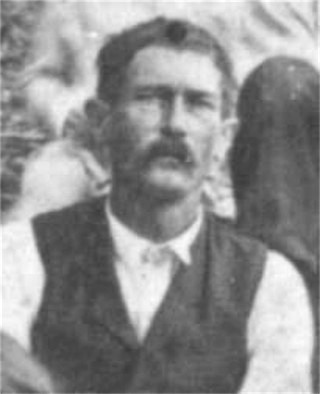 |
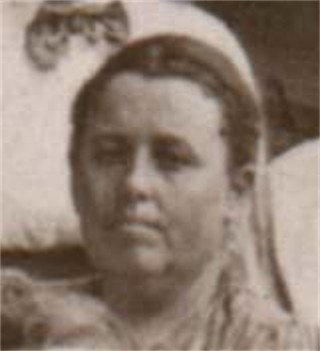 |
|
| |
|
Etta Eliza White’s family migrated from Tennessee and settled at Bluewater Creek, in Lauderdale County. They ran a stage-coach station and inn. This structure was built in the late 1700’s or early 1800’s. Oral history says this house was built by the Cherokee chief Doublehead, who died in 1807. The year 1812 was carved in one of the logs on the second floor. By 1818, native Americans had lost claim to land north of the Tennessee River through a treaty with the U.S. government, and the federal land sales conducted in Huntsville opened Lauderdale County to settlement. Etta’s father, Daniel Benton White purchased this land in 1818.
At right, Archie, Mavis and Lela Snoddy (ca 1910). Aunt Lela is now 101 years young. (June 2011)
|
 |
 |
Click on the leaf to send an email to me: |
To see a PDF of my entire file on Samuel Snoddy, click leaf: |
| This web page is dedicated to the memory of our Irish cousin, Leonard Sluman; who gave so freely of his time and his boundless energy to share historical family information with his cousins from "across the pond". He is greatly missed. Leonard
Sluman |
 |